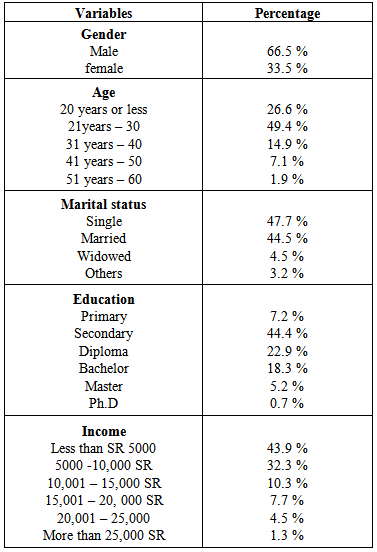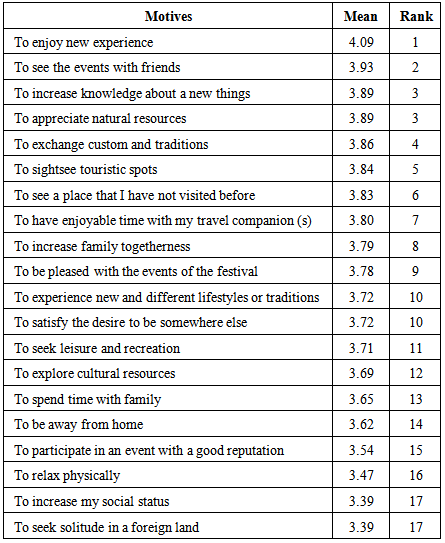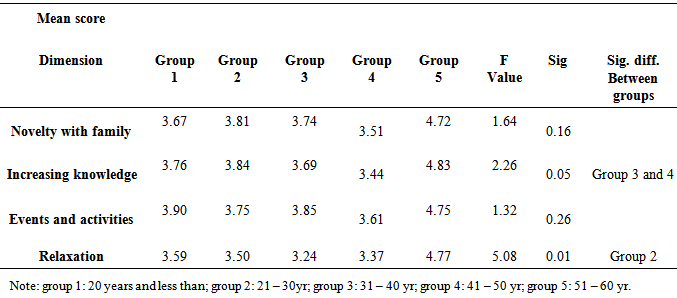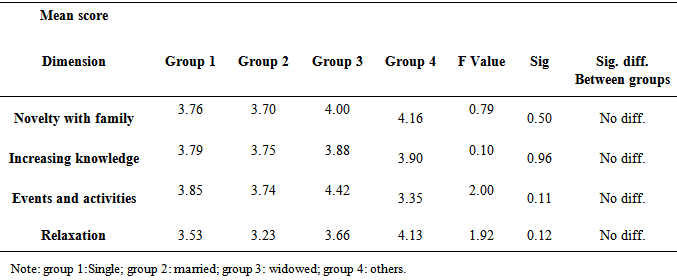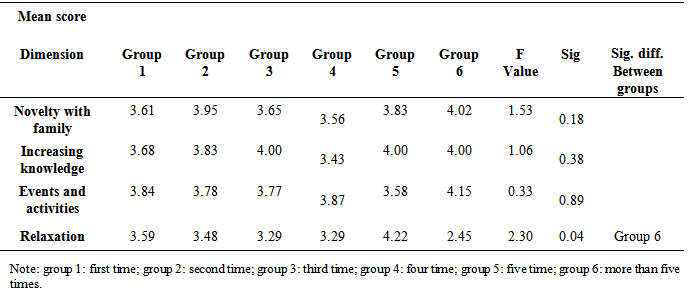-
Paper Information
- Paper Submission
-
Journal Information
- About This Journal
- Editorial Board
- Current Issue
- Archive
- Author Guidelines
- Contact Us
American Journal of Tourism Management
p-ISSN: 2326-0637 e-ISSN: 2326-0645
2014; 3(2): 45-54
doi:10.5923/j.tourism.20140302.01
Festival Tourism in Saudi Arabia: A Study of Image and Motivation of Participating in Janadriyah Festival
Bashar Aref Alhaj Mohammad
Institute of Public Administration, Kingdom of Saudi Arabia
Correspondence to: Bashar Aref Alhaj Mohammad, Institute of Public Administration, Kingdom of Saudi Arabia.
| Email: |  |
Copyright © 2014 Scientific & Academic Publishing. All Rights Reserved.
Festival events have been studied by various researches as an important motivation for tourists in the world. Many destinations throughout the world have extended events to attract tourists. The importance of festival events is considered as a valuable tool for promoting and understanding market segmentation based on tourists motivation. The purpose of the study is to identify the main factors that attract Saudi to participate in Janadriyah festival, and to test if there is any statistical significant between demographic variables and motivational factors. A questionnaire is conducted to collect primary data from a convenient sample of Saudi tourists selected for this purpose during summer season 2014. The results indicate that Novelty with family and Increasing knowledge are the most important motivational factors to participate in Janadriyah.
Keywords: Events, Festivals, Tourism, Motivation, Destination image
Cite this paper: Bashar Aref Alhaj Mohammad, Festival Tourism in Saudi Arabia: A Study of Image and Motivation of Participating in Janadriyah Festival, American Journal of Tourism Management, Vol. 3 No. 2, 2014, pp. 45-54. doi: 10.5923/j.tourism.20140302.01.
Article Outline
1. Introduction
- Most studies in the field of festival and cultural events are related to places, even for experientially based scholars. Although there is a key relationship between personal identity and location of these festivals (Gonzalez, 2008). In addition, festivals are integral to all societies. They celebrate cultural heritage and identity as well as provide opportunities for the revitalization of communities and the development commerce and employment (Ferdinand & Williams, 2013). In relation to heritage events, festivals are incorporate commercial activity, attracting interested attendees and acting as market places for cultural products (Turgay & Dikmen, 2013). In other words, there has been a growing interest in festivals and cultural events for purely economic and social impacts (Andersson & Lundberg, 2013). Some of these events and festivals may go further to attract foreign tourists as well (Ferdinand & Williams, 2013). Literature review on travel motivation reveals that tourists are motivated to satisfy their needs and wants (Lee et al, 2004, Park et al. 2010, Kim et al. 2010). In other words, tourist motivation indicates that the analysis of motivations based on the two dimensions of push and pull factors have been generally accepted (Yuan & McDonald, 1990; Uysal & Hagan, 1993). The concept behind motivation dimension is that people travel because they are motivated to destination attributes. Getz (2008, p.403) noted that "events are an important motivators of tourism, and figure prominently in the development and marketing plans of most destinations". It is important to come out with the different motivation that drives tourists to attend and participate in these festivals (Turgay & Dikmen, 2013). According to Lawton & Weaver (2002) approximately 10,000 festivals are organized annually in the USA and over 31 million visitors. Also, around 1000 festival organized in Texas (Crompton & McKay, 1997). Approximately, in Britain, over 1000 cultural events were organized by "British Tourism Authority" in 1995 which resulted 50 million pound spent by international tourists (O'Sullivan & Jackson, 2002, p. 325). Moreover, in Finnmark (Region in northern Norway), almost 60 festival are organized annually in 19 municipalities (Jaeger & Mykletun, 2009). The tourism product includes event and festival are considered as magnificent celebrations to the country which include dance, music, culture arts and handcrafts (Getz, 2008, Egrest & Kara, 2014). From marketing perspective, it is very important for managers of destination to provide quality product in the festivals and events to examine the tourists behavior and intention to revisit these events in the future (Kim et al, 2010). In addition, Yoon & Uysal (2005, p45) stated that "in an increasingly saturated marketplace, the success of marketing destination should be guided by a thorough analysis of tourist motivation". According to Getz (1991, p. 11) stated that "festivals and public celebrations are found in all societies. Together with a variety of other special events, they are increasingly seen as unique tourist attractions and as destination image markets.
2. Statement of the Problem
- Since this paradigm of tourism is always related to human beings and human nature, it is a complex proposition to investigate why people travel and what they want to enjoy (Yoon & Uysal, 2005). Investigating and identifying the factors that influence travel motivation are very important to effectively understand motivations and offer better tourism products for different market segments (Jang & Wu, 2006). The study seeks to understand tourist motivations of different view of Saudi tourists who participated Janadriyah festival, in the light of the issue that Janadriyah receives a proportionately high participated number of tourists. Understanding their motivations and perceptions help marketers and decision makers formulate effective marketing strategies and achieve competitive advantages in the country. Recognizing the main reasons that drive tourists to participate in the festival and events are very critical issues in the tourism industry. Crompton & McKay (1997) confirmed that motivations of tourists are considered the main point of decision process. Moreover, identifying the motives that attract tourist to visit festivals are important to increase the enjoyment and recreation of the tourists during these events (Dewer et al, 2001). It also create visitors satisfaction and increase market competitiveness through identifying the main reasons that lead visitors to attend festival events. From marketing perspective, Formica & Uysal (1998) assured that successful destination marketing show the efforts from hinge of effective segmentation. Tourist motivations differ from one person to another because of their needs and wants that are associated with various tourism products and services (Park et al. 2010). Tourists motivation may be different from event to event (Scott, 1996; Rachael & Douglas, 2001. Generally, visitors are participating in tourism festivals are likely to share same motives in attending these events and try to know about other culture and background (Lee et al, 2004). Once the motivations of tourists to attend the festivals have been identified, it is wild space and gap of study to find the relationship between these motivation of attending tourism festivals and perception of tourists about this type of tourism product. Even if the researchers have studied this area, still there are some challenges in finding the relationship between that tourist drives to visit and participate in the festivals and events. It is also not easy to investigate why people travel and how they satisfy their needs. (Yoon & Uysal, 2005). On the other hand “motives may change over time and occasion” (Seaton & Bennett, 1996, p.68).
3. Janadriyah Festival
- Janadriyah village is on the outskirts of Riyadh. The area covers 1.5 sq km and has replicas of buildings representing all the different Provinces of the Saudi Kingdom such as Jizan, Asir, Najd, Makkah, Medinah, Al Baha, Qassim, Najran and many others. The Janadriyah Village is located on Janadriyah Road, opposite the Salwa Garden Village. Further along the same road are the King Abdul Aziz Race track and Thumamah National Park sand dunes. Three roads from Riyadh lead to Janadriyah. It takes about 30- 45 minutes from Riyadh city center to reach Janadriyah depending on the traffic. Moreover, there are so many places to see and things to do when entering the festival area. Tourists can see camel races, camel riding, falcons, horse racing and endurance, folk poetry, popular market, arts and popular games, unique heritage of the regions, folk costumes, book fair, centre for documentation and pictures. They can also see the governmental institutions and companies and what the interiors of houses of different areas in Saudi Arabia look like. Tourists can also try traditional foods, watching sword dancing, learn about the history of Saudi Arabia, and visiting some museums. The annual Janadriyah festival has been the national heritage and culture organized by the National Guard in Janadriyah historic since 1986. It hold in the field of culture and an indication of profound significance for the attention of culture, heritage, traditions and values of Arabian horses. A lot of people visit this festival every year, also there is awards for participants. According to Alriyadh newspaper dated on 2 March 2014, At the conclusion of the festival Janadriah 29 visitors outpacing the 10 million barrier (www.alriyadh.com). Moreover, every year there is host country of the world to participate in the festival, China was the host country in the 2014 Janadriyah festival.
4. Literature Review
4.1. Festivals Events and Motivations
- Cultural events are mostly used to attract a magnificent number of tourists from different areas to exchange experience and activities (Turgay, 2013, Egrest & Kara, 2014). Thus, events tourism has become one of the fastest growing types of tourism (Egrest & Kara, 2014). Based on O'Sullivan and Jackson (2002, P. 325) festivals were defined as "a phenomenon in which people from outside a festival locale visit during the festival period". Also, Gonzalez & Morales (2009) defined events as experience that are unique and they have ability to create time and space to convey specific objectives for a specific audience. Events and activities are considered as positive benefits to their host community and increasingly becoming one of the fastest growing types of tourism attraction in the world (Andersson & Lundberg, 2013). In addition, Chang (2006, p.1224) asserted that "community festivals and special events have grown rapidly in number throughout the world during the past decade". Hence, Lee et al (2004) asserted that events and festivals having strong cultural components are likely to increase number of participations. According to (Tyrgay & Dikmen, 2013), attending festival events could be related to many factors such as accessibility, entertainment, performance, and relaxation to go along this idea, "events are important motivators of tourism, and figure prominently in the development and marketing plans of most destinations” (Getz, 2008, p. 427). Getz (1993) acknowledged that festivals events play an important role in people's lives because they involve significant activities, provide sending outlets for local and visitors, and encourage local community's image. Events are also provide an opportunity for promoting what community are presenting in this events (Turgay, 2013). Many academic researchers have been studied the festivals and events to understand many factors such as cultural impact. From marketing perspective, festival events are increasingly being used as instruments for promoting tourism and boosting regional economy (Felsenstein & Fleischer, 2003). Also, events can encourage tourism development and attract visitors to a destination and increase its attractiveness (Knowles, 2004). Currently, festivals occupy significant status as part of the tourism market and consciously developed as attractions for tourists (Picard & Robinson, 2006b; Gets, 2008). Event tourism is important in the tourism industry and attract potential tourists to visit these events and become a vital market in their business (Getz, 2008). A review of the literature on motivation reveals that people travel because they are ‘‘pushed’’ into making travel decisions by internal, psychological forces, and ‘‘pulled’’ by the external forces of the destination attributes (Uysal & Jurowski, 1994; Yoon & Uysal, 2005). Several empirical studies have reported that novelty seeking is a key motive in tourism, and especially in relation to special events (Crompton, 1979). Motivation is internal factors that direct and integrate a person's behavior (ISO-Ahola, 1980). From this point, it is vital to study, recognize and understand consumer behavior because “tourism behavior focuses deeply on individuals’ thinking and behavior relating to discretionary travel behavior (March & Woodside, 2005). In tourism, it is widely acknowledged that motivation is a preliminary point in studying tourist behavior (e.g. Yoon & Uysal, 2005) because motivation is about why tourists behave as they do (Hsu et al. 2008, p. 77).
4.2. Destination Image
- Molina et al. (2010, p.722) claimed that “destination image is commonly accepted as an important aspect in successful tourism management and in destination marketing”. According to Gartner (2000), an image is a critical factor in underlying the destination selection. The concept of destination image has spurred interest among researchers in the last two decades (Schneider & Sonmez, 1999). Crompton (1979, p.18) defined destination image as “the sum of beliefs, impressions, ideas, and perceptions that people hold of objectives, behaviors, and events”. Destination image is very important for consumers to choose a destination. It influences consumer's behavior from two points: the destination decision making and the condition after decision making, such as participation (experience), evaluation (satisfaction), intention (recommendation) (Lee et al., 2005). In order to understand the two main factors in this study (push and pull factors), it is very important to unleash the concept of destination image. Generally, studying destination image and its influence on tourists' behaviours has been acknowledged in tourism research (Lee et al. 2005; Chen & Tasi, 2007). From marketing perspective, Yilmaz et al. (2009) claimed that image plays a significant role in destination marketers and promotions. Furthermore, information source like promotional tools represented by brochures, advertisement, as well as friends and relatives have great influence on the formation of destination image (Beerli & Martin, 2004). There are several factors influencing consumer's behaviour judgment. According to the results obtained from the model, the characteristics are of two information sources (individuals and characteristics); both characteristics have an effect on the system of interrelationships and on perceiving compound images. Baloglu and McCleary (1999a) suggested a theoretical model of formation image factors. It distinguished between stimulus factors (previous experience, information sources, and distribution) and personal factors (social and psychological). The research by Lee et al. (2005) studied Korean’s destination image formed by the 2002 World Cup. Their study focused on several behaviour intentions. The results indicated that there were four dimension factors that influenced destination image. According to Yoon & Uysal (2005), tourists choose their destination based on the image and on their motivation to satisfy their needs and motives. Chen & Tasi (2007) investigated tourist's behaviour model including destination image and the relationships between the variables in different stages of consumer behaviour. The results showed that the destination image has a direct and indirect effect on tourists' behaviour and on their intentions. According to Chen & Hsu (2000), the destination image can be classified into three categories: pre-trip, during trip, and post-trip. The pre-trip includes personal traits, such as psychograph, experience, and motivation. During trip behavior includes tourists' perceptions of service quality and the amount of money spent in trip. Importantly, most of the studies on tourists' behavior in post-trips are concerned with satisfaction, the intent of return, and the impact of tourism on the community.
5. Research Methodology
5.1. Questionnaire Design and Variables
- In order to achieve research objectives, measure tourist motivation and destination image to participate in Janadriyah festival, the study utilized 26 motivational to identify the main reasons that drive tourists to participate in the festival. All the motives items were developed on related literature (Robertson & Chabres, 2007 Getz, 2008; Turgay & Kidmen, 2013). A five points Likert scale was used to measure tourist motivations variables with assigned value ranking from highest to lowest 5 "very important" to 1 "not important at all". The questionnaire includes four parts: demographic profile such as (gender, age and marital status), characteristics of festival visit like (number of visits Janadriyah festival), the reason for visiting and participating in these festivals, and the evaluation of tourist participation in Janadriyah festival.
5.2. Data Collection Procedures
- Prior to conduct to real survey, a pilot study of 42 tourists was done before a few weeks earlier from opening Janadriyah festival to ensure that the research instrument is suitable for respondents to gather data. The reliability was tested by SPSS software, the result of Cronpach’s Alpha was 0.9533. Malhotra and Birks (2007) point out that choosing the most appropriate data collection methods and procedures are one of the most significant steps for successful research study. Using available facilities to achieve data collection, the research team visited Janadriyah festival to meet real respondents to collect data. The questionnaire was translated into two languages English and Arabic by professional professors. Over 300 questionnaires were distributed in the festivals. Out of which 269 were returned (represent rate was 89 %) and 247 were usable for analysis. The duration of distributing questionnaire started from 12 – 28 February 2014.
6. Data Analysis and Results
- Factor analysis, independent sample t- test and one way ANOVA were used in order to analyze the results and to indentify the importance of motivational factors influencing Saudi tourists to participate in Janadriyah festival.
6.1. Demographic Profile
- The socio-demographic profile of sampled Saudi tourists who participated in Janadriyah festival were profiled and presented in table 1. Frequency analysis of the sample showed that majority of visitors were male (66.5 %), and most of visitors were between ages 21-40 years (64.3 %). the largest part of respondents were single and married (92.2 %), and had education secondary school (44.4 %), and majority of the respondents have income between less than SR 5.000 – 10, 000 (76.2 %).
|
6.2. The Importance of Motives and Evaluate Visitation to Janadriyah
- Table 2 reports the importance of motives that drive Saudi tourist to participate in Janadriyah festival. "enjoying new experience" was the most important motive among all factors for Saudi tourists (m = 4.09), followed by "seeing the events with friends" (m = 3.93), and last was increasing knowledge about a new things" (m = 3.89).
|
6.3. Factor Grouping of Motives
- To underline the motivational factors of Saudi tourists to participate in Janadriyah festival, principal component factor analysis with a Varimax rotation was used. The Kaiser-Meyer-Olkin (KMO) measure of sampling adequacy is 0.87, and total variance is 54.71. All factors with an eigenvalue greater than 1 were chosen. Six items were deleted due to the factor loading less than 0.4 or because they loaded on several factors simultaneously (Suleiman & Mohamed, 2011, Alhaj Mohammad & Mat som, 2010; Kim et al, 2003). Table 3 illustrates the results of 19 motivational factors that drive Saudi tourists to participate in Janadriyah festival. The factors grouping of motivations that drive Saudi tourists are "Novelty with family", "Increasing knowledge", "Events and activities", and "Relaxation". Out of four underlying motives, "Novelty with family" is the most important motive for Saudi tourist to participate in Janadriyah festival. It obtains 6.93 eigen value and 15.86 % variance followed by “increasing knowledge”, “events and activities”, and “relaxation” simultaneously.
 | Table 3. Factor Analysis of Motives |
6.4. Motivational Factors with Demographic Profile
- One of the purposes of the research is to find out if there are any statistical significant differences between motivational factors and demographic profile. Tables (4 - 7) report the results of independent sample t-test and analysis of variance (ANOVA) accordingly. The results of the study show that some significant differences for motivational factors across some of demographic variables. Table 4 reports the results of independent sample t-test of gender with motivational factors. The results point out that woman perceive motivational factors more than male, due to the nature of life in Saudi for woman. Women in Arabia are not allowed to drive a car or travelling alone. They also dress special clothes according to the Saudi traditions and customs. Accordingly, this event gives the chance to Saudi women to exchange knowledge, experience and culture. The results in table 5 indicated that there are some significant differences between "increasing knowledge"; "relaxation" with age. For example, Saudis participated in the festivals age from 21 to 50. It means that the youth and family prefer to participate in the festival. There is no significant difference between motivational factor with marital status. These factors may not be strongly related to the people who participate in the festival. Table 7 shows the results of motivational factors with number of visit. It shows that there is no significant difference between motivational factors and number of visit except "relaxation". This may be due to the nature of relaxation factors compared with other factors.
|
|
|
|
7. Discussion, Conclusions and Recommendations
- The research mainly studies the motivational factors that attract Saudi tourists to participate in Janadriyah festival. Tourist motivation is being faced a kind of motives to move to feel satisfied (Alhaj Mohammad, 2014; Yoon & Uysal, 2005). Thus, this travel from place to another was needed to re-balance push and pull factors (Crompton, 1979). Huge needs are satisfied by travelers when they attend festivals (Crompton & McKay, 1997). Kim et al. (2006) and Zyl & Botha (2004) confirmed that motivations related to family togetherness were crucial during the festival due to the activities and the managers of the festival who attracted huge number to attend. Moreover, the results of the study indicated that events and activities were the main factors that drive Saudi to participate in the festival. Thus, this goes along with Gursoy et al. (2004) who showed that participation in the festivals or special events is being active member in the community, and good citizens. Also, tourists perceived values when they visited a festival as Kim et al. (2010) stated. The results also linked with Axelsem and Arcodia (2004) who focused on some general motives that drive people to attend festival such as relaxation and learning about other culture, which found in this study. Majority of festival and events are draw from a relatively community and local area (Crompton & McKay, 1997). Such festivals offer a unique and valuable contribution to the community and it comes to provide and support the local area Weiler & et al. (2004). Hence, over the past years, there was increased in the number and size of the festivals (Zyl, 2010). The results of the study also show that Saudis like and are motivated to attend same events and cultural festivals. This goes along with Getz (2008) who assure that events are considered very important motivator for tourism and major factor for development and marketing plans in the destinations. The results also confirm Zyl’s (2010) findings which insist the motivation factors for attending Aardklop national festivals. Segmenting festivals and events markets and understanding the main motivational factors and tourist characteristics are essential for successful festival managers and organizers in the future (Lee et al. 2004). Hence, understanding how customers acquire information is important for marketing management decisions (Molina et al. 2010). Moreover, corresponding the importance of festival market segmentation as a valuable marketing tool for promotion and understanding market characteristics based on motivation will bring success destination (Lee et al. 2004; Yoon & Yusal, 2005, Kim et al. 2011). The study offers an attempt to understand the main motivational factors that attract Saudis to participate in Janadriyah festival. It suggests that the conceptual framework of motivation of tourists, image of festivals and participation in the events are crucial in festival success. The study also confirms that tourists' travel is driven by external factors such as escaping and seeking novelty factors that in literature was generally supported. In other words, tourists are motivated to participate in festivals and events because they want to satisfy intrinsic desire and, at the same time, where to go depend on destination attributes. However, In order to identify the motivational dimension, a principle component and factor analysis were used to recognize the main motivational factors that drive Saudi to participate in Janadriyah festival. Three items were eliminated due to factor loadings of less than 0.4 or they loaded on several factors simultaneously. Nineteen motivational items were analyzed using Varimax Rotated procedures to identify the underlying dimensions that were associated with motivations. All items have an eigen value that is greater than one and they are divided into four factors that motivated Saudi to participate in Janadriyah festival. These factors are “Novelty with family”, “Increasing knowledge”, “events and activities”, and “Relaxation”.The study has provided important contributions to recognize factors that attract Saudi to visit Janadriyah festival. Underlying and knowledge the importance of tourists motivation perceived from Saudi tourists will help the destinations and decision maker to provide better services and products that face tourists needs and wants. In addition to the implications, understanding travel motivation and participation to Janadriyah festival such as psychological and socio-demographic factors may help tourism practitioners to design and guide tourism strategies in the country. The empirical results of this study provide tenable evidence that tourist motivation is closely with destination advantages and image. In Saudi Arabia, tourism is increasingly becoming important sectors for creating job opportunities and bringing foreign currency. A successful matching of tourist motives is essential for a marketing strategy in destination areas, and the careful study of the motives are useful in segmenting markets, designing promotional programs, and decision-making about destination development. Identification of a clearly defined market segments permit specifically directed promotion programs. Thus, the tourism authorities in Saudi Arabia can develop a variety of different marketing strategies based on specific motivations of tourist market in order to satisfy their underlying needs. The research findings have identified the importance of travel motives of Saudis to attend Janadriyah festival, and this should become the foundation for tourism authorities and marketers to design appropriate marketing programs and promotional campaigns to increase number of tourists who participate in the festival. Moreover, in designing the appropriate marketing programs, tourism marketers in the country must understand the market characteristics and select the tools correctly. This is particularly true because designing the promotion mix is even more complex when one tool used to promote another. For examples, each promotional tool like advertising, promotion and public relations has unique characteristics and costs. When developing their promotional mix, tourism marketers in Saudi must consider factors such as type of tourism products and markets, motivation strategies as identified in the study, and tourism product life cycle stage.The study also states that Saudi tourists differ in terms of their motivations, perceptions, and travel characteristics from others. Thus, tourism organizations in the country must employ demographic segmentation which consists of dividing the domestic tourist market into groups based on their demographic variables. This is particularly important as tourists’ needs, and wants. The demographic variables are deference from people to others, and this was evident from the motives and perceptions of respondents in the study. As capital resource is limited, demographic characteristics must be known to assess the size of the target market and to reach it efficiently. In addition, the study finds that the respondents had an overall good assessment of their trip to the festival, and most of them had the intention to revisit the country in future. Thus, marketers must attempt to build brand loyalty through relationship marketing. This can be achieved if hospitality and travel marketers have direct contact with the tourists or customers, develop a guest history database, and use this information to customize offers and customer communications. In other words, they should stay in contact with former guests through direct mail and lets them know the special events, and new programs and facilities in order to encourage vital repeat business.The study, however, has its own limitation as the study does not examine the interacting among participant and the events in the festivals. Moreover, motivation is only the main factors that drive Saudi to participate in Janadriyah festival. For future research, the study recommends to measure the level of Saudi satisfaction after participation and their opinion about the event at all.
ACKNOWLEDGMENTS
- The author is grateful to Associate Professor Dr. Ibrahim Abu shihab and his family for giving Professional technique to proofread this paper.
 Abstract
Abstract Reference
Reference Full-Text PDF
Full-Text PDF Full-text HTML
Full-text HTML